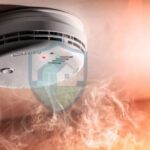Do you wish to know whether Can SLC And NAC Be In The Same Conduit? Yes, it is acceptable to run SLC and NAC in the same conduit as long as all the grounds are connected together and the wires are marked in the box and panel so they can be easily identified.
As an electrical contractor, I learned the hard way how improper wiring can lead to issues when I lost a large project due to interference between circuits.
The customer’s building had major functionality problems with their new system, which I had to rip out and re-install.
This motivated me to research the standards thoroughly before taking on another fire alarm project.
In this article, I’ll share what I’ve learned about best practices for running SLC and NAC according to code requirements.
My goal is to help other contractors avoid the mistakes I made by providing clear, in-depth guidelines for conduit usage in fire alarm wiring.
Let’s dive in.
Can SLC And NAC Be In The Same Conduit?
Before deciding whether SLC and NAC can share a conduit, it’s important to understand what these circuits do in a fire alarm system and their individual wiring requirements.
What is an SLC?
SLC stands for Signaling Line Circuit. This circuit connects the fire alarm control panel to devices like smoke detectors, pull stations, beam detectors, etc. The SLC is used to both supply power to devices and receive signals back from them.
According to NFPA 72, the National Fire Alarm and Signaling Code, SLC wiring must be survivable. It should be fire-rated to function for a certain period of time under fire conditions. Typically two hours. The SLC should also be installed in a closed loop so that a single break doesn’t disable the entire circuit.
Common wire sizes for SLC are 18 AWG to 14 AWG. Voltage on the loop is typically 24VDC. Wiring distances up to 12,500 ft from the panel are allowed.
What is a NAC?
NAC stands for Notification Appliance Circuit. This circuit connects the fire alarm control panel to notification devices like strobes, horns, speakers etc. The NAC activates these devices upon alarm to alert building occupants.
NAC circuits don’t need to be as survivable as SLCs. They should maintain operation for a minimum of 15 minutes under fire conditions. NAC circuits can be wired as Class A (closed loop) or Class B (radial) per NFPA 72.
Typical NAC wiring is 14 AWG to 12 AWG. The circuit operates at 24VDC usually. Maximum wiring distance is also 12,500 ft.
Key Differences
While both SLC and NAC operate at low voltage DC levels, a key difference is their function. SLCs provide communications while NACs simply switch notification devices on/off.
Survivability requirements are more stringent for SLC to maintain the ability to communicate with devices during a fire. NAC only needs to sound alarms for evacuation.
Another difference is SLC loops while NAC can be looped or radial. And SLC supports addressable devices while NAC just powers notifications.
Individual Requirements
Per NFPA 72, SLC must be separated from all other wiring and routed through its own conduit. This prevents interference with the fire alarm communications.
NAC does not require dedicated conduit. But if shared with other circuits, proper isolation is still needed to prevent issues like ground faults.
So both SLC and NAC have wiring separation needs to maintain their individual performance. This sets the stage for whether they can safely co-exist in a shared conduit. We’ll explore that question next.
Conduit Installation Guidelines
Properly installing conduit is critical to maintain safety and performance of fire alarm system circuits. Both the NEC and NFPA 72 provide requirements to follow.
Conduit Fill Limits
The National Electrical Code (NEC) specifies maximum fill limits for the amount of conductors allowed in a conduit. This ensures no overcrowding which can lead to heat issues.
For fire alarm wiring less than 2 inches in diameter, NEC Table 1 states a maximum fill of 40%. So only 40% of the interior area can be taken up by wires.
NFPA 72 echoes this 40% limit. It also requires at least 25% spare capacity in conduit for future expansion of circuits.
Conduit Types and Sizes
Rigid metal conduit (RMC) and electrical metallic tubing (EMT) are commonly used for fire alarms due to their durability and resistance to damage.
Plastic conduits can be used in protected areas inside the building. Flexible metal conduit is useful for short runs to devices.
Minimum conduit size is typically 3/4″ but can go up based on the conductors needed. Use conduit sizing charts to calculate required diameter. Oversizing is better than undersizing.
Separation Needs
Within conduit, NFPA 72 requires maintaining separation between power limited and non-power limited wiring. Commonly 1 inch minimum.
It also prohibits combining fire alarm circuits with other systems like security, so each type should be separated. This prevents EMI interference.
Even different fire alarm circuits like SLC and NAC may need dedicated conduits depending on manufacturer guidelines and AHJ.
Isolation from Power
Sections 12.5.5.2 and 12.5.5.3 of NFPA 72 cover the separation and isolation requirements between power and fire alarm wiring.
They must be routed through different conduits with limited exceptions. Crossings should be at right angles.
This separation is critical to avoid coupled voltage and EMI that can disrupt the sensitive fire alarm communications.
Properly installing conduits with capacity for expansion, separation between circuits, and isolation from power is essential for any fire alarm system to maintain integrity. This lays the foundation for evaluating if SLC and NAC can co-exist.
Can SLC and NAC Share a Conduit?
Based on the specific wiring needs of each circuit, the thought of running SLC and NAC in the same conduit may seem unwise. However, NFPA 72 does provide some allowances under certain conditions.
Potential Interference Issues
The main concern with housing SLC and NAC together is interference. The sensitive SLC loop could pick up noise and crosstalk from being bundled with other conductors.
NAC circuits can produce electromagnetic interference (EMI) as well as introduce voltage from even small wiring faults. This could disrupt the clean communications required on SLC.
Shared conduits also make troubleshooting trickier when problems arise. It’s harder to isolate the source of issues with everything grouped together.
Noise and Crosstalk Challenges
Electrical noise and unwanted signals coupling from wires running adjacent is a real issue to consider.
For example, capacitive coupling between conductors can cause small voltage levels to bleed from NAC over to SLC. This can register as false signals or make it hard to detect real ones.
Proper bonding and grounding helps mitigate this but can’t always prevent coupling when crammed together in conduit.
NFPA 72 Allowances
However, despite the risks, NFPA 72 does not outright prohibit combining SLC and NAC in conduit.
Section 12.5.5.3.1 states: “SLCs shall be permitted to occupy the same enclosure, cable, or raceway as signaling line circuits and notification appliance circuits…”
So sharing is permitted provided other requirements are met.
Meeting Conduit Fill
A key requirement is that conduit fill limits are adhered to. Trying to jam too many wires exceeding 40% capacity will exacerbate issues.
Proper sizing of conduit along with pulling in spare conductors allows room for circuits to co-exist while remaining up to code.
The next section covers other best practices to implement when sharing conduit between SLC and NAC.
Recommended Wiring Practices
While NFPA 72 permits combining SLC and NAC in conduit, doing so successfully requires following best practices:
- Maintain at least 1 inch separation between SLC and NAC inside conduit. Do not bundle together.
- Use shielded SLC cables like FPL, FPLR or FPLP rather than unshielded twisted pairs. The shielding helps reject noise.
- Pull in spare conductors to avoid exceeding 40% fill capacity as wires get added over time.
- Use conduit bonding and grounding to eliminate voltage differences between SLC and NAC and avoid EMI.
- Follow manufacturer guidelines for their recommended wiring methods. Many want SLC and NAC separate.
- Only combine where runs are short and straight. Long parallel runs alongside NAC increase risk of interference on SLC.
- Consider using conduit solely for SLC whenever possible, even if more expensive. This guarantees its integrity.
- Where sharing conduit, use junction boxes to split apart and maintain separation of SLC and NAC on their individual paths.
Compliance with Codes and Standards
When installing fire alarm system wiring, it’s critical to adhere to all applicable codes and standards. Here are key requirements related to sharing conduit between SLC and NAC.
NFPA 72 Chapter 12
Chapter 12 of NFPA 72 covers the installation of wiring for fire alarm systems. Key sections include:
- 12.5.5.3 – Separating power-limited and non-power limited wiring
- 12.5.5.3.1 – Allowance for SLC and NAC in common enclosure
- 12.5.6 – Wiring installation requirements
- 12.6 – Requirements for notification appliance circuits
Reviewing Chapter 12 in detail can uncover additional mandates or advisory guidance related to how SLC and NAC wires are routed.
NEC Article 760
NEC Article 760 focuses on fire alarm system wiring and equipment. While it does not prohibit SLC and NAC in shared conduit, key requirements include:
- 760.3(F) – Conductor separation, splices, insulation
- 760.24 – Mechanical execution of work
- 760.130 – Wiring methods and materials – cables, conduits
- 760.176 – Conductor sizes for signaling and notification circuits
Careful review of Article 760 can help identify any related conduit usage requirements.
AHJ Policies
The local Authority Having Jurisdiction (AHJ) may also have policies prohibiting or restricting combining SLC and NAC in conduits.
Check with the AHJ to see if they mandate fully separate conduit usage or have other specific wiring rules. Get any restrictions or allowances in writing.
Inspection and Documentation
Finally, properly document the wiring installation and have it inspected and approved. Keep records of the conduit layout and construction.
Ensuring everything is done to code and documented thoroughly will avoid issues or delays getting final system approval.
By understanding all the applicable standards and getting AHJ approval, contractors can confidently move forward with sharing or separate conduits for SLC and NAC based on codes.
Frequently Asked Questions
Below are answers to some common questions that come up regarding fire alarm system wiring:
What is the Difference Between SLC and NAC circuits?
The SLC (Signaling Line Circuit) connects fire alarm devices like smoke detectors back to the main panel for monitoring. It supplies power and also transmits signals.
NAC (Notification Appliance Circuit) wires only connect notification devices like strobes and horns. SLC is a loop while NAC can be looped or radial. Also, SLC supports addressable devices while NAC just activates all devices together.
Can Multiple Circuits Be in The Same Conduit?
It depends. Best practice is to separate different circuit types like SLC, NAC, and others. But NFPA 72 does permit certain circuits to share conduit if separation and fill requirements are met. However, most manufacturers recommend fully dedicated conduits.
Can We Have Fire Alarm System Wires and Normal Lighting Wires in The Same Conduit?
No, regular building wiring should never be combined with fire alarm circuits according to NFPA 72. The only exception is very short sections when crossing perpendicularly. Fire alarm wiring must be fully isolated to avoid interference.
Does Fire Alarm Cable Have To Be In Conduit?
Yes, NFPA 72 requires installing fire alarm wiring in metal conduit or raceways. The only exception is short final runs to devices can use plenum-rated cables. All main fire alarm circuit runs must be fully enclosed in conduit or armored cable.
What Does NAC Mean in Electrical?
NAC stands for Notification Appliance Circuit. This refers specifically to the wiring from the fire alarm panel to the notification devices like strobes, horns, and speakers that activate to alert building occupants of an emergency.
What are SLC Circuits Used For?
SLC (Signaling Line Circuit) wires connect the fire alarm control panel to initiating devices like smoke detectors, heat detectors, pull stations, etc. The SLC supplies power to the devices and also transmits signals back from them to the panel.
What Does NAC Mean On a Fire Panel?
On a fire alarm control panel, the NAC terminals connect to the notification appliance circuits. This is the output that activates strobe, horn, and speaker devices when an alarm is triggered to notify building occupants. Panels have separate NAC terminals for each circuit.
What Devices Are On a NAC Circuit?
Notification appliances like horns, strobes, speakers, and combo horn/strobes are wired to NAC circuits. These devices receive power from the NAC wiring to activate upon alarm and alert building occupants of a fire emergency.
How Many Horn Strobes Does a NAC Circuit Have?
The number of strobes and horns allowed on a NAC circuit depends on their power draw and the gauge of NAC wiring used. Typical good practice is 10-20 devices per NAC, but the fire alarm system designer performs load calculations to determine capacity.
What Is The Voltage Of a NAC Circuit?
NAC circuits operate at a low voltage, usually 24VDC. This allows the wiring to power multiple notification appliances in the loop while minimizing voltage drop issues. The fire alarm panel converts 120/240 VAC to 24VDC for the NAC circuit.
Conclusion
The question of whether SLC and NAC can share conduit requires careful consideration. While NFPA 72 allows it, the best practice is to separate them to avoid any interference issues.
If conduit must be shared, follow the recommendations covered to minimize noise and crosstalk. Never overfill shared conduits, as exceeding 40% capacity is asking for problems.
Always coordinate SLC and NAC installation carefully, using junction boxes to split apart and maintain separation. Finally, diligently meeting all code requirements and manufacturer guidance ensures shared or separate conduits both avoid issues. With proper planning and precautions, SLC and NAC can co-exist successfully in conduit if needed.




